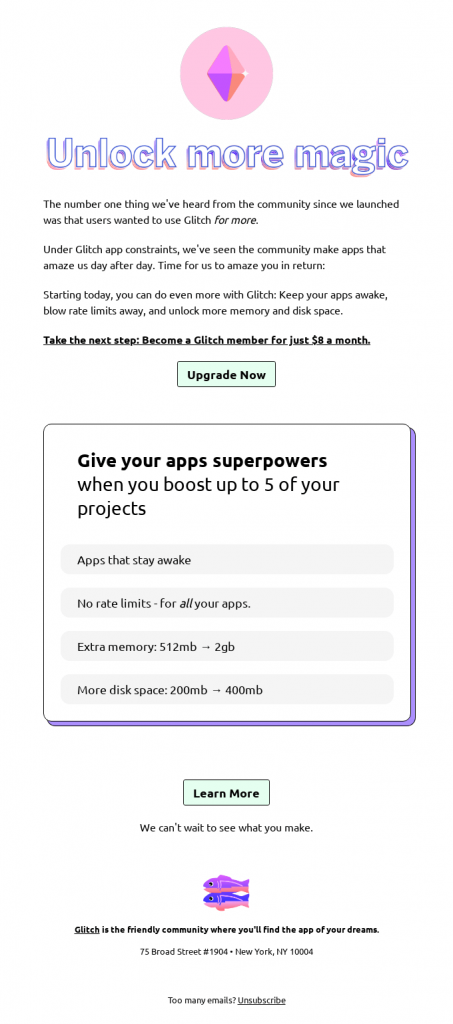Email Retargeting: How it Works & Best Practices with Examples
It’s normal for customers to come and go, but how do you actually make them stay?
Digital marketing offers a myriad of strategies, and retargeting ads are among them. It usually involves ads generated based on a consumer’s previous online behavior.
But what if you want to deliver a more personalized experience than just bombarding people with images of products all around the internet?
In this case, email retargeting might be a better option.
Not sure what we’re talking about?
Stick around – we’ve got all the answers.
What is Email Retargeting?
Email retargeting is a marketing strategy based on recording the behaviors your existing customers have exhibited and using this data to create a highly targeted email campaign. This tactic is also known as email-based retargeting or email remarketing.
Essentially, this strategy can help you re-engage dormant customers or reactivate prospects who are on your list, have shown some interest, but haven’t converted yet. The best examples are cart abandonment emails (you can check out a few of them in this article).
How does email retargeting work?
Retargeting usually involves cookies – bits of data a web server sends to a potential customer’s web browser. This data is stored in the browser, helping you track their behavior, i.e., other web pages they visited and products they’ve recently purchased.
However, even though the cookie method is legit, it’s getting harder to use it with some browsers. For instance, in Google Chrome, you can set limits on websites using these files or restrict them completely:
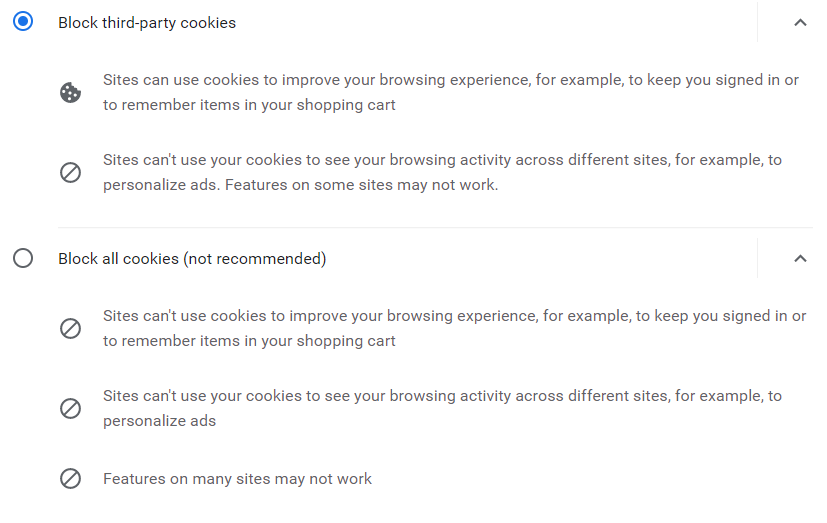
What can you do in this case?
There are two other options available:
- Pixel tracking – this method is possible in remarketing software with the functionality to use pixels (bits of code) in the HTML versions of your emails or on your website. This software leaves pixel files in your target’s browser, allowing you to keep an eye on their online behavior. The obvious perk is that pixels cannot be blocked.
- Addresses available through your email service provider – in other words, it’s your lead list or subscriber register. You have their contacts, they’ve left some trace, so you can use it to segment them, identify where they are in the sales funnel, and send an email tailored to their needs.
Regardless of the method you choose, your emails will require A/B testing and a proper content strategy to ensure you achieve the results you expect.
If you’re wondering about pixel tracking, such popular tools as Mailchimp, Zoho Mail, Optinmonster, and PastePixel make this approach possible. And the prices are not too high. Optinmonster, for instance, only costs $30 a month (as of January 2022).
3 Benefits of Email Retargeting
Okay, since now you have an idea of what email-based remarketing is, let’s determine the actual data-driven benefits it can bring you.
Benefit #1: Higher conversion rates
We all know that lead generation costs a lot of money. And, of course, there is a risk that some prospects will not convert as fast as others, but it doesn’t mean you can’t retarget them again.
If you’re facing a problem with low conversion rates, and none of the other marketing efforts to fix this have worked, you can give email remarketing a try. Using its methods, you can trace consumer behavior, figure out what your clients currently might be interested in, and pinpoint their needs with a tailored email. And, since you are directly addressing their pain points, the email open rates will also be higher.
How high can conversion rates get if you use this remarketing approach?
According to Moz, at least for ecommerce websites, CR can theoretically increase by 41%. It’s impressive, given that the usual ecommerce conversion rate is about 2%. Surely, it is only possible thanks to the highly personalized approach that email retargeting involves.
Benefit #2: Increased target consumer traffic
Traffic is one of the prioritized KPIs for many businesses, both B2B and B2C. However, the one that’s coming from your target audience is the most valuable since it means your ideal customer is interested in your offering.
How can email retargeting bring you more consumer traffic?
Take a look at the case study from Data Dynamix, a company that helps businesses improve their digital marketing strategies, including email marketing campaigns.
The study involved a business from the house renovation industry, and its goal was to boost sales and attract homeowners interested in home improvement; they also had to come from a specific location.
To bring this plan to life, Data Dynamix targeted 55,000 ideal customers within the given area and sent them an initial email newsletter to promote the client’s home improvement services. Then, using mobile device IDs and IP address targeting, they’ve put together an email remarketing campaign.
The results were more than satisfactory – the email campaign brought back a 13.83% open rate and 1.73% click-through rates. But most importantly, the client got more brand awareness and target consumer traffic to the website, with 97% of all impressions resulting from email-based remarketing.
Benefit #3: Improved customer loyalty
Let’s say you have a customer who’s been with you for a few years. They’ve been buying your products consistently, so now you’re convinced they’ll stay with you forever.
Well, unfortunately, customer loyalty is not a thing you can rely on these days. According to HubSpot, 50% of loyal customers have left their preferred company for a competitor who managed to stay more relevant and cater to their needs.
See, if you don’t do anything about your existing buyers and focus all your efforts on getting new ones, you will lose a bigger chunk of your revenue.
How can email remarketing help?
As we mentioned, this method involves behavior-based customer segmentation, allowing you to single out specific needs your loyal buyers are currently having and use that to personalize offers in your marketing emails.
If you involve email remarketing to address your existing customers’ pain points on a continuous basis, the idea to swap you for your competitors will be less likely to cross their minds.
5 Best Email Retargeting Practices (with Examples!)
Alright, now you understand the idea behind email remarketing strategy and the benefits it can bring.
But what does it take to execute it the right way? Is it enough to get an inbound marketing tool and a CRM that will do all the work for you?
Surely, email marketing automation could take a massive load of work off your shoulders, but relying on email tools alone won’t do the trick.
Yes, email retargeting is data-driven, but it also requires the human touch. Customer data only shows you a direction towards clients’ needs, but it’s your call, how to address them.
Besides, remarketing in general often involves a content marketing strategy, and here you might get stuck looking for the best ways to use content to attract the ICP’s attention.
That’s why we’ve put together five practices with email examples to help guide your retargeting strategy.
1. Upselling existing customers
Since we finished our list of email retargeting benefits with customer loyalty, let’s talk about upselling as a way to keep your existing clients interested.
Upselling is a tactic of encouraging a consumer to purchase a higher-end product based on what they’ve previously bought from you. Today, the meaning of upselling has also expanded to exposing a buyer to other product options or service upgrades and not necessarily selling something more expensive.
Does this method actually work?
Indeed, it might seem confusing – who would want to purchase something more expensive? People usually look for affordable prices and deals to save money instead.
Well, that’s true, but they’re also willing to splurge if the product answers their urgent need. Apart from that, based on Sumo’s research, about 95% of an average business’s revenue comes from upselling. So, it definitely affects a customer’s purchase decision.
Upselling is a perfect suit for email-based retargeting – you go through the previous purchases a customer has made, pinpoint the most frequently bought products, and offer something of higher value.
Example: Glitch
As we mentioned, product upgrade also counts as an upsell, and Glitch, an app development platform, has a perfect example of a retargeting email using this strategy:
In the message, Glitch informs its customers that it decided to implement the features they requested to expand the platform’s app development toolkit. And based on customer feedback, Glitch returns with a follow-up containing an upselling offer.
This email is an excellent example of combining customers’ dire needs with something they’ve been looking for. Besides, such offers undoubtedly have a positive impact on customer loyalty as you give people what they want.
2. Following up on abandoned carts
All businesses suffer from shopping cart abandonment. If you take a look at the graph below, you’ll see that the percentage gap of abandoned carts is not that drastic when comparing B2B and B2C industries:
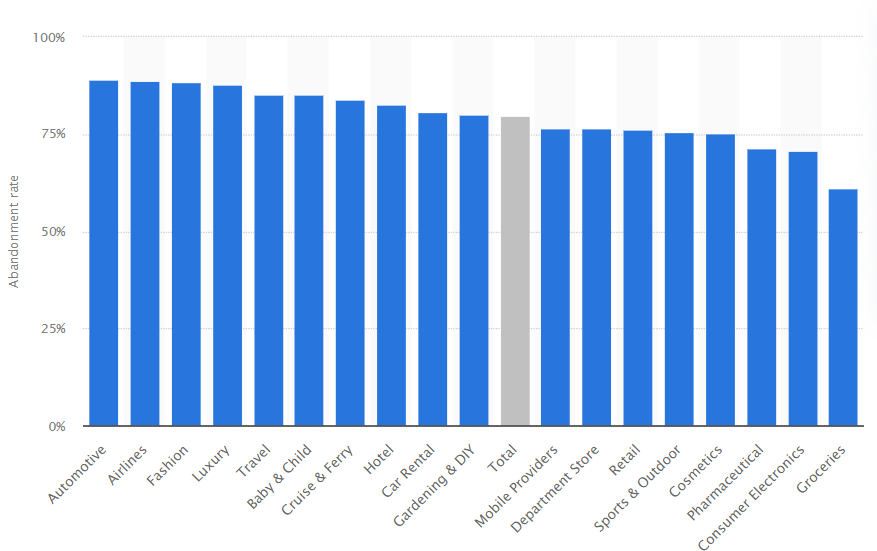
So, you should expect that some of your first-time site visitors won’t follow through with placing an order. However, it doesn’t mean you should abandon them in return. Instead, you can use email retargeting to re-engage them.
But what is the best way to do it to actually attract their attention?
Think about why a visitor didn’t buy the product they wanted. Shopify suggests the following most common reasons:
- The item costs too much
- Registration is required
- Long checkout process
- Unclear pricing
- No trust in the website
Study visitor behavior to single out the most plausible reason they didn’t buy the product. This data will help you develop a personalized email with a customized offer.
Example: 7 For All Mankind
Let’s take the first most common reason why people abandon carts – they find items too expensive for their budget. And 7 For All Mankind, a manufacturer of denim clothes, has its own email example showing a perfect solution for this problem:

Basically, in your cart abandonment emails, you retarget a visitor with an email offering a lucrative discount for the items they left in the cart. It’s also important to use a call-to-action reminding them to view the cart. As a result, you tackle the issue that prevented them from buying the products they wanted, increase their satisfaction rate, and convert a visitor into a customer.
For better optimization, you can also combine this approach with cross-selling by offering extra products similar to the ones a visitor placed in the cart to drive even more interest.
3. Reactivating dormant subscribers
Now, let’s talk about using email remarketing to awaken inactive subscribers on your email list.
But how can you identify the reason why a subscriber went radio silent in the first place?
By trying to understand their behavior, of course. Campaign Monitor singles out three types of dormant subscribers:
- (Temporarily) Dormant or unengaged – they were active for a while but are now on a cool-down period, and you want to know whether they are coming back.
- Zombies – they were once active users but have gone off the radar and haven’t opened any of your emails in a while.
- Ghosts – they signed up for your newsletter, probably for a whole other reason than actively using your product or service. Their demographics also might not fit your ICP.
So, you can evaluate a subscriber based on these characteristics to determine which email retargeting approach to use to try and reactivate them.
Example: Adoric
Let’s skip the first two types of dormant subscribers and go straight to the third one. How do you re-engage someone who’s never been active? Is it even worth it to waste your resources on them?
As we mentioned, it’s never a good idea to give up on a subscriber, even if they don’t seem interested in you. And when you do decide to give up, at least you will know that you’ve done everything to change their mind.
So, how do you reach out to a ghost?
Since we’re talking about subscribers, a spiritual seance won’t help here. Instead, you might want to analyze the last action they made and use it as a starting point for a conversation. Adoric, a powerful tool for lead generation, uses this approach in its email retargeting campaigns:
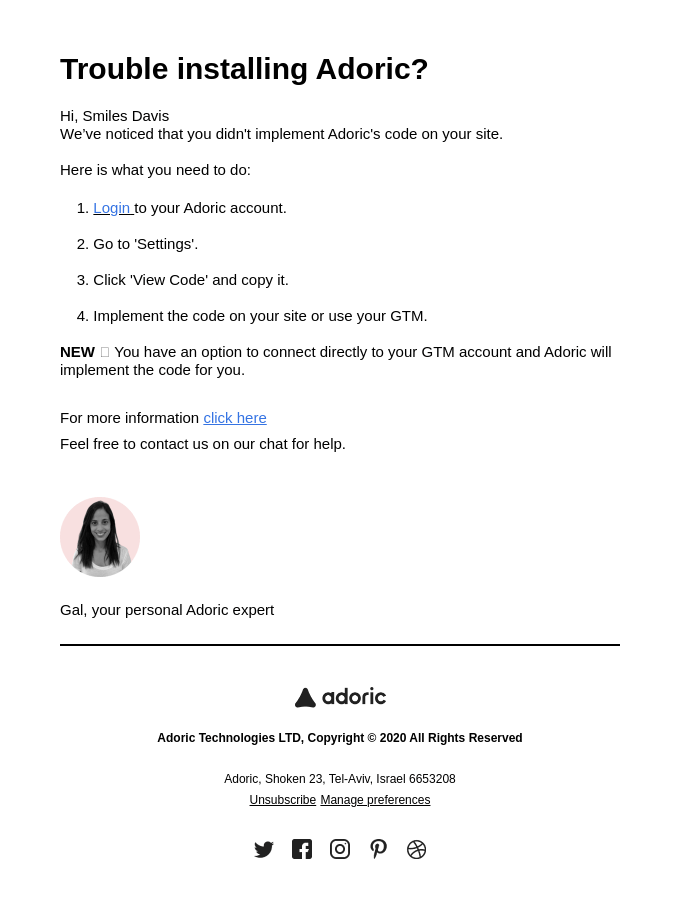
The idea is to address a person’s last action associated with your product or service both in the subject line and the body of the email. Then, you indicate that they didn’t follow through with this action and show them how to do it.
In a way, this email resembles abandoned shopping cart messages – they also serve both as reminders and re-engaging tools at the same time.
4. Retargeting website visitors
What if a visitor repeatedly browsed through some of your website pages but didn’t place any products in the cart?
In this case, most businesses resort to ad retargeting. For example, you visit a page with a leather skirt on the Mohito website (an ecommerce shop). The website places browser cookies, and then you see this skirt among other product offers in display ads on Google partner websites and social media channels:
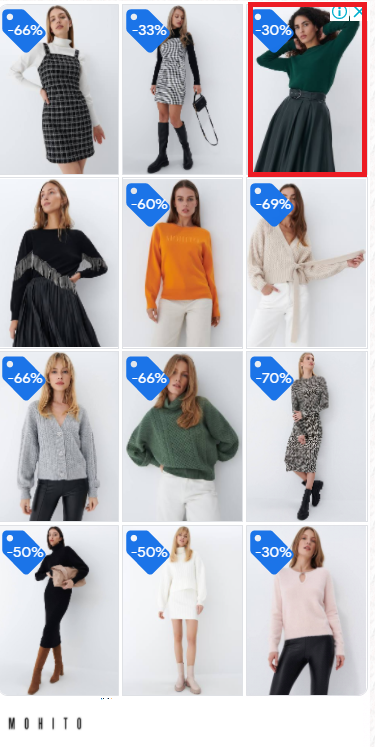
But can you do the same with an email?
Of course! In this case, an email retargeting strategy is even better since you also get a chance to highlight the benefits of the product a visitor is interested in using engaging content and visuals.
Example: Adidas
In the email below, Adidas demonstrates how to use email remarketing to re-introduce a visitor to a certain product:

You can see the image of the product right at the top of the email, along with a short but engaging text asking a visitor why they didn’t go through with the purchase. The email is complemented with a set of CTAs directing the recipient to order the product.
To amplify the effect of this message, Adidas also added social proof. As a result, you have a convincing retargeting email that proves the product’s value and aims to convert inactive visitors into new customers.
5. Using onsite pop-ups
One more common remarketing practice worth mentioning involves behavior-triggered pop-ups. Usually, they are used as data collection forms to get contact information from potential prospects.
In this case, however, you use pop-ups for onsite retargeting or monitoring the behavior of website visitors and taking action to engage them. Companies frequently use this strategy to prevent visitors from leaving a website or landing page by offering something valuable.
Does it work?
Oh yes, it does – according to Optinmonk, pop-ups have an average conversion rate of 11.09%. This percentage can get even higher if you use the right pop-up type.
Example: Fashion Nova
Since we mentioned that websites usually do onsite retargeting to keep a visitor on the page, let’s take a look at an example that shows this strategy in action.
Fashion Nova, an ecommerce website, uses a pop-up that appears right as you start moving your mouse to close the tab:
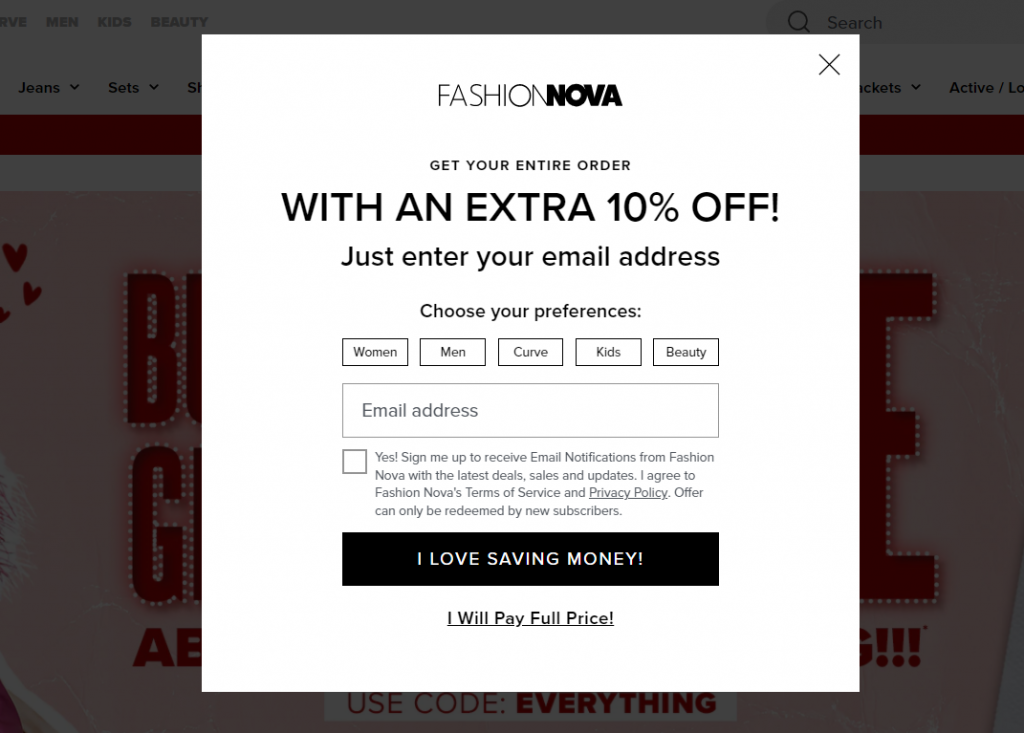
This pop-up engages the visitor by offering an extra 10% discount given that the person provides their email.
You can also use this method to get more email subscribers, invite a visitor to sign up for a free trial or ask them to leave feedback. Choose the pop-up based on what your goal is with onsite retargeting. If you want to increase conversions, then Fashion Nova’s example is the right one to follow.
Now Over to You
Email remarketing and retargeting, in general, serve a good purpose – they give you a chance to get more clients by following their customer journey and making personalized product recommendations.
Besides, there are plenty of practices you can try out. Let’s recap all of them:
- Upselling existing customers
- Following up with an abandoned cart email
- Reactivating dormant subscribers
- Targeting website visitors
- Using onsite retargeting
Each of them helps you understand customer behavior better and find an approach that will facilitate their interest in your product or service.
Are you interested in more articles like this? Check out our DMW blog – we have many more engaging and informative pieces there!
Frequently Asked Questions (FAQs)
Let’s answer a few additional questions to provide a bit more insight into the topic of email-based remarketing.
Q1. What is a disadvantage of email retargeting?
Some consumers may perceive behavior-triggered emails as stalking. That’s why email retargeting, although effective on a general level, can force them to unsubscribe, especially if your email design makes it look spammy.
Q2. What’s the difference between email retargeting and email marketing?
Email marketing is a general term for all the activities it involves. Email retargeting is a tactic used to send emails to existing customers based on their behavior and interests.
Q3. How long does it take for an email to be delivered?
On average, it takes an email a few seconds to a few minutes to arrive. However, if an email is poorly designed, the delivery time can be longer.
Q4. How effective is email retargeting?
If executed properly, email retargeting can bring impressive results. According to research by Moz, this strategy can bring a 41% conversion rate.

Mariia is a content strategist and editor at Digital Marketer’s World. She is passionate about educating others on all things marketing and believes in the power of the written word.

